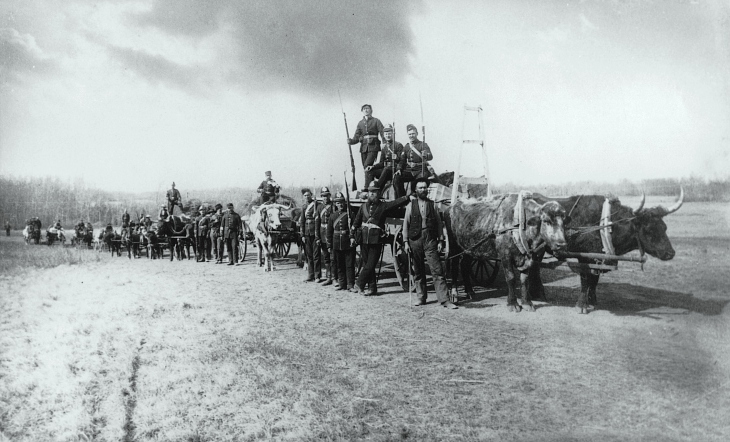|
Muskowekwan 85-71
Muskowekwan First Nation ( oj, Mashkawigwaning) is a Saulteaux ( Ojibway) First Nation who inhabit approximately 100 km northwest of Melville, Saskatchewan, Canada. As of May, 2008, the First Nation has 1,517 registered people, of which their on- reserve population was 400. History Chief Ka-nee-na-wup ( Anishinaabe language: ''Geniinewab'', "One Who Sits Like an Eagle") and his Saulteaux band lived along the Upper Qu'Appelle Lakes prior to signing Treaty 4 on September 15, 1874. When Ka-nee-na-wup died, his son Muscowequan or Muskowekwan ( Anishinaabe language: ''Maskawigwan'', "Hard Quill") became chief. A reserve was surveyed in 1883, incorporating the settlement where they had already started farming. On September 15, 1874, the Crown signed Treaty 4 with “the Cree, Saulteaux and other Indians,” including Chief Ka-kee-na-wup on behalf of Muskowekwan First Nation. Treaty 4 has also been known as the Qu'Appelle Treaty, as its first signings were conducted at For ... [...More Info...] [...Related Items...] OR: [Wikipedia] [Google] [Baidu] |
Saulteaux
The Saulteaux (pronounced , or in imitation of the French pronunciation , also written Salteaux, Saulteau and other variants), otherwise known as the Plains Ojibwe, are a First Nations band government in Ontario, Manitoba, Saskatchewan, Alberta and British Columbia, Canada. They are a branch of the Ojibwe who pushed west. They formed a mixed culture of woodlands and plains Indigenous customs and traditions. Ethnic classification The Saulteaux are a branch of the Ojibwe Nations within Canada. They are sometimes called the Anihšināpē (Anishinaabe). ''Saulteaux'' is a French term meaning "people of the rapids," referring to their former location in the area of Sault Ste. Marie. They are primarily hunters and fishers, and when still the primary dwellers of their sovereign land, they had extensive trading relations with the French, British and later Americans at that post. Location The Saulteaux historically were settled around Lake Superior and Lake Winnipeg, principal ... [...More Info...] [...Related Items...] OR: [Wikipedia] [Google] [Baidu] |
Muskowekwan 85-28
Muskowekwan 85-28 is an Indian reserve of the Muskowekwan First Nation in Saskatchewan. It is 105 kilometres west of Yorkton. In the 2016 Canadian Census The 2016 Canadian census was an enumeration of Canadian residents, which counted a population of 35,151,728, a change from its 2011 population of 33,476,688. The census, conducted by Statistics Canada, was Canada's seventh quinquennial census. ..., it recorded a population of 0 living in 1 of its 1 total private dwellings. References Indian reserves in Saskatchewan Division No. 10, Saskatchewan {{Saskatchewan-IndianReserve-stub ... [...More Info...] [...Related Items...] OR: [Wikipedia] [Google] [Baidu] |
Touchwood Tribal Agency Council
Touchwood is decayed wood used for tinder. The phrase "touch wood" is another way of describing knocking on wood. The terms may also refer to Geography in Canada * Touchwood Hills, a range of hills in Saskatchewan * Rural Municipality of Touchwood No. 248 The Rural Municipality of Touchwood No. 248 ( 2016 population: ) is a rural municipality (RM) in the Canadian province of Saskatchewan within Census Division No. 10 and Division No. 4. History The RM of Touchwood No. 248 incorporated as ..., Saskatchewan * Touchwood (electoral district) a former provincial electoral district which was merged to create Last Mountain-Touchwood in 1975 * Touchwood Hills Post Provincial Park a provincial park and historic site in Saskatchewan * Touchwood Lake (Alberta) * Touchwood Lake (Manitoba) Business * Touchwood Pacific Partners, an American film financing partnership founded by The Walt Disney Company * Touchwood, Solihull, a shopping centre in the West Midlands of England ... [...More Info...] [...Related Items...] OR: [Wikipedia] [Google] [Baidu] |
Western Ojibwa Language
Western Ojibwa (also known as Nakawēmowin (ᓇᐦᑲᐌᒧᐎᓐ), ''Saulteaux'', and ''Plains Ojibwa'') is a Ojibwe dialects, dialect of the Ojibwe language, a member of the Algonquian languages, Algonquian language family. It is spoken by the Saulteaux, a subnation of the Ojibwa, Ojibwe people, in southern Manitoba and southern Saskatchewan, Canada, west of Lake Winnipeg. ''Saulteaux'' is generally used by its speakers, and ''Nakawēmowin'' is the general term in the language itself. Classification Genetically, Ojibwa is part of the Algonquian language family. This language family includes languages like Mi'kmaq language, Mi'kmaq, Abenaki language, Abenaki, Malecite-Passamaquoddy language, Malecite, Potawatomi language, Potawatomi, Delaware languages, Delaware, Innu language, Montagnais-Naskapi, Cree language, Cree, and Blackfoot language, Blackfoot in Canada. In the U.S., are languages such as Menominee language, Menomini, Fox language, Fox, Shawnee language, Shawnee and Chey ... [...More Info...] [...Related Items...] OR: [Wikipedia] [Google] [Baidu] |
Fort Qu'Appelle
Fort Qu'Appelle is a town in Canadian province of Saskatchewan located in the Qu'Appelle River valley north-east of Regina, between Echo and Mission Lakes of the Fishing Lakes. It is not to be confused with the once-significant nearby town of Qu'Appelle. It was originally established in 1864 as a Hudson's Bay Company trading post. Fort Qu'Appelle, with its 1,919 residents in 2006, is at the junction of Highway 35, Highway 10, Highway 22, Highway 56, and Highway 215. The 1897 Hudson's Bay Company store, 1911 Grand Trunk Pacific Railway station, Fort Qu'Appelle Sanatorium ( Fort San), and the Treaty 4 Governance Centre in the shape of a teepee are all landmarks of this community. Additionally, the Noel Pinay sculpture of a man praying commemorates a burial ground, is a life-sized statue in a park beside Segwun Avenue. Demographics In the 2021 Census of Population conducted by Statistics Canada, Fort Qu'Appelle had a population of living in of its total private ... [...More Info...] [...Related Items...] OR: [Wikipedia] [Google] [Baidu] |
